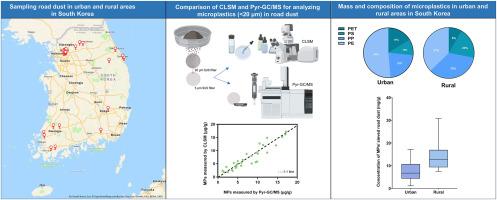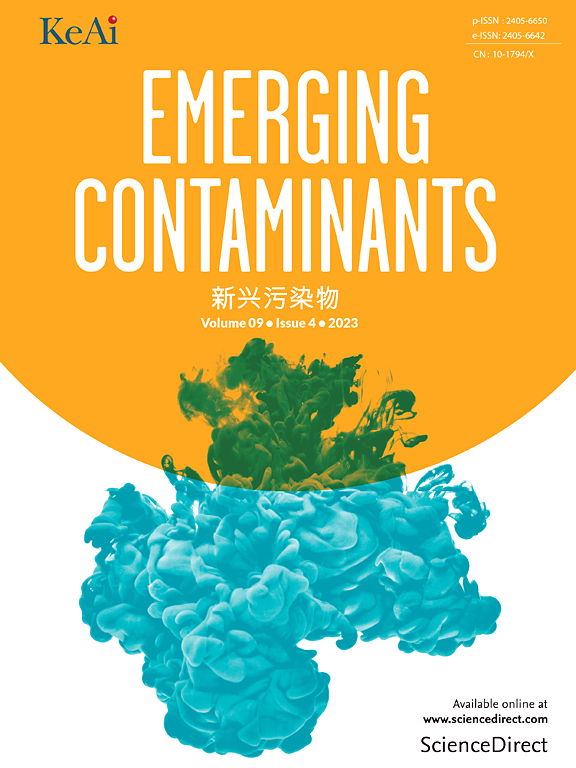用共聚焦激光扫描显微镜(CLSM)和热解-气相色谱/质谱法(Pyr-GC/MS)评价道路粉尘中20 μm以下的微塑料
IF 6.9
2区 环境科学与生态学
Q1 ENVIRONMENTAL SCIENCES
引用次数: 0
摘要
检测20 μm以下的微塑料(MPs)具有挑战性,但这些微小颗粒可能对人类健康和环境构成重大威胁。它们可以被吸入或摄入,可能导致呼吸系统疾病和胃肠道问题。本研究提出用共聚焦激光扫描显微镜(CLSM)鉴定小于20 μm的MPs,并将结果与典型的用热解-气相色谱/质谱法(Pyr-GC/MS)对道路粉尘样品中这些小MPs的重量分析结果进行比较,以支持其有效性。在首尔市区共收集了30个道路粉尘样本,在韩国农村地区收集了15个样本。CLSM和Pyr-GC/MS的测定结果非常吻合,证实了这两种方法在测量20 μm以下的MPs时的有效性,特别是当聚烯烃占主导地位时。CLSM与BiofilmQ软件相结合,可以进行精确的体积分析,而Pyr-GC/MS可以快速鉴定化学成分,这表明它们是互补的。农村道路粉尘中MPs的质量浓度(14.2±6.4 μg−1)高于城市道路粉尘(7.8±4.6 μg−1),这可能是由于农村地区塑料废物管理不严格和农用塑料使用增加所致。本研究建立在先前的体积成像方法的基础上,利用CLSM对20 μm以下的MPs进行了质量定量,并与实际道路粉尘样品中的Pyr-GC/MS验证了结果。本文章由计算机程序翻译,如有差异,请以英文原文为准。

Assessment of microplastics under 20 μm in road dust using confocal laser scanning microscopy (CLSM) and pyrolysis-gas chromatography/mass spectrometry (Pyr-GC/MS)
Detecting microplastics (MPs) under 20 μm has been challenging, yet these tiny particles may pose significant threats to human health and the environment. They can be inhaled or ingested, potentially leading to respiratory diseases and gastrointestinal problems. This research proposed confocal laser scanning microscopy (CLSM) for identifying MPs smaller than 20 μm and to support its validity by comparing results to a typical gravimetric analysis for these small MPs in road dust samples using pyrolysis-gas chromatography/mass spectrometry (Pyr-GC/MS). A total of 30 road dust samples were collected from urban areas in Seoul and 15 samples from rural regions throughout South Korea. A strong agreement was observed between the results obtained from CLSM and Pyr-GC/MS, confirming the effectiveness of both methods in measuring MPs under 20 μm especially when polyolefins are dominating MPs. CLSM, coupled with BiofilmQ software, enabled precise volumetric analysis, while Pyr-GC/MS provided rapid identification of chemical compositions, suggesting that they are complementary. Mass concentrations of MPs in rural road dust (14.2 ± 6.4 μg g−1) were greater than those in urban road dust (7.8 ± 4.6 μg g−1), likely due to less stringent plastic waste management and increased agricultural plastic use in rural areas. This study builds upon prior volumetric imaging methods by enabling mass quantification of MPs under 20 μm using CLSM and validating the results against Pyr-GC/MS in real-world road dust samples.
求助全文
通过发布文献求助,成功后即可免费获取论文全文。
去求助
来源期刊

Emerging Contaminants
Medicine-Public Health, Environmental and Occupational Health
CiteScore
10.00
自引率
6.70%
发文量
35
审稿时长
44 days
期刊介绍:
Emerging Contaminants is an outlet for world-leading research addressing problems associated with environmental contamination caused by emerging contaminants and their solutions. Emerging contaminants are defined as chemicals that are not currently (or have been only recently) regulated and about which there exist concerns regarding their impact on human or ecological health. Examples of emerging contaminants include disinfection by-products, pharmaceutical and personal care products, persistent organic chemicals, and mercury etc. as well as their degradation products. We encourage papers addressing science that facilitates greater understanding of the nature, extent, and impacts of the presence of emerging contaminants in the environment; technology that exploits original principles to reduce and control their environmental presence; as well as the development, implementation and efficacy of national and international policies to protect human health and the environment from emerging contaminants.
 求助内容:
求助内容: 应助结果提醒方式:
应助结果提醒方式:


